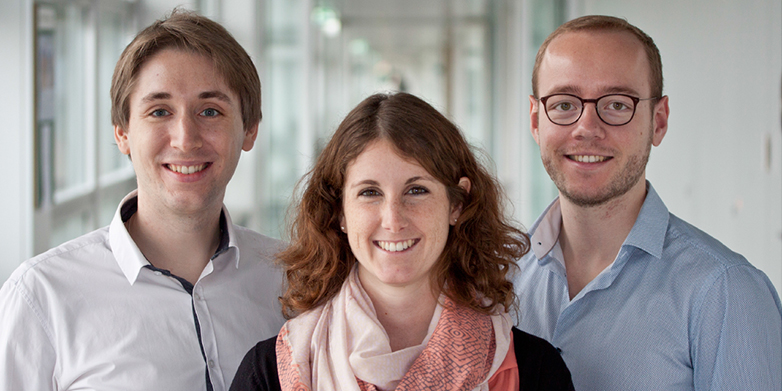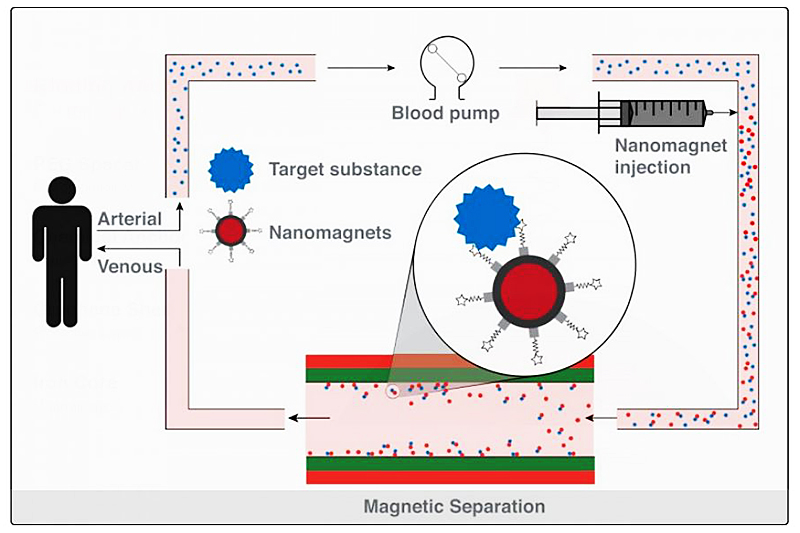Magnetic forces purify the blood
Every five seconds, someone in the world dies from blood poisoning. Hemotune, a young start-up founded by ETH researchers, is developing a revolutionary blood purification system to address this problem.

Lukas Langenegger picks up a small glass ampoule containing a dark, reddish-brown fluid. Then he holds a magnet against the vial, and iron particles accumulate on the edge of the glass as if by magic, leaving behind a crystal-clear fluid. This simple demonstration illustrates the concept behind a new method for purifying blood.
The basic principle is to use nanoparticles to bind toxins in the blood and then separate them by magnetic forces. The procedure employs a similar extracorporeal circuit to that used in dialysis: the blood is pumped out of the body, treated and then fed back into the patient’s bloodstream. “ETH has been researching these methods for some time,” explains Lukas Langenegger. “Now we want to translate our research into clinical practice.” To achieve this, Lukas Langenegger has teamed up with Carlos Mora and Corinne Hofer to establish the start-up HemoTune.
After leaving school, Lukas Langenegger initially worked as a trainee with a major Swiss bank before moving on to ETH Zurich to complete first a BSc and then an MSc degree in chemical and bioengineering. Carlos Mora is a biologist specialising in immunology, and Corinne Hofer is a chemist. These three colleagues met in the ETH’s Functional Materials Laboratory led by Professor Wendelin Stark.
Focus on acute blood poisoning
“Our focus is on the treatment of acute blood poisoning,” explains Langenegger. This condition, also known as sepsis, is a frequent complication of diseases such as pneumonia. Every year around 19 million people die from sepsis worldwide. It is by far the most common cause of death, claiming the lives of around 12 people per minute. Four out of every ten victims do not survive the disease.

When infected by sepsis, the body typically releases high concentrations of endotoxins, a harmful substance produced by disintegrating bacteria. Removing these toxins is one of the most promising approaches to treating the disease, but conventional blood purification methods often struggle to systematically and efficiently remove certain toxic substances. The new technology is designed to overcome these limitations. “The removal of bacterial toxins should significantly improve the survival rate of victims,” says Langenegger.
HemoTune therefore continues to explore its revolutionary method using nanoparticles. The initial clinical trials should start in the next three years. Until then, there is a lot to do. “We have to ensure that our blood purification method satisfies all the regulatory requirements for medical products.” The nanoparticles need to be manufactured in customised reactors and tested in specially certified laboratories, and then the efficacy of the blood purification method has to be tested under real conditions. The top priority here is to minimise potential risks and side-effects. Although everything seems to point to good biocompatibility so far, these tests are vitally important for the efficacy of Hemotune’s technology.
Cutting-edge technology with multiple benefits
What makes Langenegger confident about the new method succeeding in the market? “The key advantage over traditional methods is that our nanoparticles selectively remove individual endotoxins. On top of that, the technology is more efficient and biocompatible than existing filter-based methods,” he explains.
The three researchers currently earn their living from their teaching posts at ETH Zurich. To push their project forward, however, the team now needs to raise more money – and lots of it! The young entrepreneurs have already won several competitions for business ideas, including the Venture Kick Award, receiving prize money totalling tens of thousands of francs along the way. “But now we need several million to fund the clinical trials,” confirms Langenegger. With such huge sums involved, careful planning and a rigorously structured approach is vital if the three young researchers are to succeed. “No one is simply going to hand over several million. We therefore have to be absolutely clear about what we want and be able to demonstrate the viability of our technology,” stresses the young entrepreneur.
If everything goes well, Hemotune could well take a big leap forward with their financing this winter, as they are already involved in appropriate negotiations. If the project does achieve a commercial breakthrough, it won’t be purely down to the work of the young research team, as Langenegger is keen to point out: “Without the groundwork done by our colleagues in the Functional Materials Laboratory, we wouldn’t have been able to make such good progress to date.”
